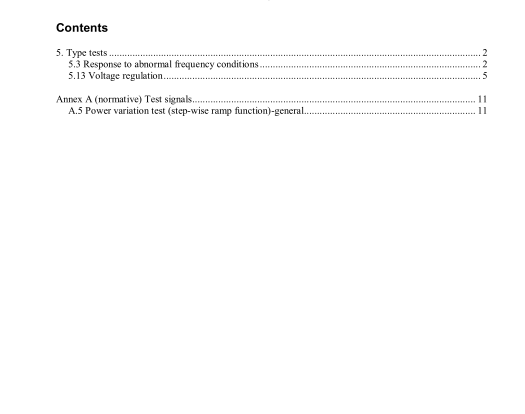IEEE 1547.1a-2015 pdf download.IEEE Standard Conformance Test Procedures for Equipment Interconnecting Distributed Resources with Electric Power Systems
5.3.3.2 Procedure
Where the EUT can respond by providing multiple characteristics, this test shall be performed with the most severe combination of characteristics of the available settings. This procedure uses the step-wise ramp function defined in A.5 and a series of test frequencies sufficient to reproduce the manufacturer’s response characteristics (including hysteresis, and dead band) with an accuracy to evaluate the manufacturer’s accuracy.
a) Connect the EUT according to the instructions and specifications provided by the manufacturer. Where the EUT requires a separate test input source to conduct this test, that source shall be capable of supplying 150% of the input power required to evaluate the EUT in this test regimen.
b) Set the EUT operating mode to the non-curtailed power output mode.
c) Set all EPS source parameters to the nominal operating voltage and frequency.
d) Set all EUT parameters to the rated real power conditions for the EUT.
e) Record applicable settings.
f) Record the EPS source frequency and the real power generated by the EUT.
g) Set the source frequency to a value (F b ) at least twice the manufacturer’s stated frequency sensing accuracy below the over-frequency power reduction initiation setting. The source shall be held at this frequency until power output is stable.
h) Step the source frequency from the initiate point to the highest frequency value (F f ) equal to the manufacturer specified final point plus twice the manufacturer’s specified accuracy using the step- wise ramp function defined in Annex A. Observe and record the time and real power versus frequency until steady state is achieved.
i) Step the source frequency from the highest frequency value (F b for step i) down to nominal (F f for step i) using the step-wise ramp function defined in Annex A. The source shall be held at this frequency until power output is stable. Observe and record the time and real power versus frequency until steady state is achieved. j) Repeat steps
g) through i) four times for a total of five tests.
k) For EUT that has the capability to be curtailed repeat steps c) through
j) at a single selected curtailment level. That level shall be between 50% and 75% of the EUT rated output without being limited by the EUT input source, however, where the EUT can respond by providing multiple characteristics and a different curtailment level results in the most severe combination of characteristics of the available settings then the test shall be performed at that level.
5.3.3.3 Requirements If used, the simulated area EPS shall meet the requirements of 4.6.1. The measurement system shall meet the requirements of 4.6.2. Where these functions have an impact on the unintentional islanding performance of the EUT, the islanding test procedure shall be conducted at those most severe settings that impact unintentional islanding performance. The manufacturer shall specify the most severe settings that produce an impact on unintentional islanding. The test agency shall evaluate and confirm the manufacturers’ specifications. The test report shall record the manufacturers’ specifications and the test agency’s means and methods used to confirm the conditions that led to confirmation of conformance to IEEE 1547a.
5.3.3.4 Criteria The EUT shall be considered in compliance if the real power output of the EUT conforms to the manufacturer’s specifications while meeting the unintentional islanding test requirements in this standard.
5.3.4 Real power increase test where the EUT responds to under frequency The manufacturer shall specify the response characteristics of the EUT real power increase in response to under-frequency events.
5.3.4.1 Purpose The purpose of this test is to verify the EUT increases its output of real power in response to under- frequency events as specified by the manufacturer. 5
.3.4.2 Procedure Where the EUT can respond by providing multiple characteristics, this test shall be performed with the most severe combination of characteristics of the available settings. This procedure uses the step-wise ramp function defined in A.5 and a series of test frequencies sufficient to reproduce the manufacturer’s response characteristics (including hysteresis and dead band) with an accuracy to evaluate the manufacturer’s accuracy.IEEE 1547.1a pdf download.IEEE 1547.1a-2015 pdf download
IEEE 1547.1a-2015 pdf download

Leave a Reply